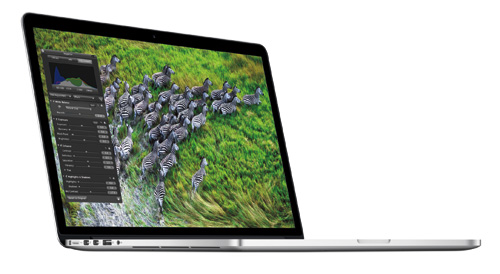Apple's new and improved MacBook Pro and MacBook Air

There was no Apple TV in sight, but Apple delivered exactly what everyone expected at today's Worldwide Developers Conference including fresh MacBooks and new versions of Mac OS X and iOS. The biggest surprise was a redesigned Apple MacBook Pro that is notably thinner and lighter, but has a super high-resolution display, faster quad-core processor and Nvidia's latest discrete graphics. The existing MacBook Airs and MacBook Pros have also been upgraded to Intel's Ivy Bridge across the board, though the designs remain unchanged.
The new MacBook Pro has 15.4-inch Retina display with a resolution 2,880 by 1,800 pixels (or 220 pixels per inch). At that density, Apple says the human eye can't discern the individual pixels (hence the Retina name first used with the new iPad, which has a density of 264 ppi). The company also says the IPS display has "deeper blacks," wider viewing angles, and less glare than the current displays. Just as with the new iPad, applications need to be updated to take advantage of a screen with such as high resolution. Apple has already updated some built-in apps such as Mail, Safari, iMovie and iPhoto as well as Aperture and Final Cut Pro, and it is working with other companies to update key applications and games such as Adobe Photoshop, Autodesk's AutoCAD and Diablo III.
Apple likes to summon Sir Jony Ive for a virtual teardown, and this year was no exception. By eliminating the glass cover on the display and using non-standard components, Apple was able to slim it down to about 0.7 inches and 4.5 pounds. That's almost as thin and light as the 13-inch MacBook Air, though the MacBook Pro doesn't have the same tapered design. The existing MacBooks Pro 15-inch, a better comparison, is almost an inch thick and weighs 5.6 pounds. HP's Envy Sleekbook 6t, which is perhaps closest in terms of design with its 15.6-inch display and slim chassis, is 0.8 inches thick and weighs 4.8 pounds. The Envy 6t is considerably cheaper, but it doesn't come close to matching the specs of the new MacBook Pro.
The MacBook Pro Retina starts at $2,199 with Intel's 2.3GHz Core i7 quad-core processor, 8GB of memory, Nvidia's GeForce GT 650M graphics and a 256GB solid-state drive. You can configure it with a faster processor, up to 16GB of memory and SSDs with capacities up to 768GB. To lighten the load you do give up some MacBook Pro features including the optical drive, Ethernet jack and FireWire port (there are accessories for all of these) but the Retina version has HDMI out, as well as two USB 3.0 ports, two Thunderbolt ports and an SD card slot.
The standard MacBook Pro still comes in 13- and 15-inch versions with the same starting prices. The 13-inch model (1,280 by 800 pixels) starts at $1,999 with a third-generation 2.5GHz Core i5 dual-core processor, 4GB of memory, 500GB hard drive and SuperDrive. Its big brother has a 15.4-inch 1440-by-900 displays and starts at $1,799 with a 2.3GHz Core i7 quad-core, 4GB of memory, a 500GB hard drive and SuperDrive. You can choose a higher resolution (not to mention faster processor and SSDs), but at that point you might as well splurge for the Retina display version. Though it wasn't mentioned, the 17-inch MacBook Pro desktop replacement has apparently been discontinued.
The MacBook Air also looks the same on the outside. You can't really blame Apple for this: As CEO Tim Cook accurately noted the PC industry is still trying to catch up with this iconic design--something that was apparent from the many new Ultrabooks at Computex last week. The starting prices remain the same, but the shift to Ivy Bridge should give the MacBook Air a nice performance boost. The 11-inch model starts at $999 with a 1.7GHz Core i5 dual-core chip, 4GB of memory and a 64GB SSD. The 13-inch one starts at $1,199 with a slightly faster processor and a 128GB SSD.
All of the new MacBooks are available now, but you'll have to wait until July to upgrade to Mac OS X Mountain Lion (it's free with a new MacBook or $19.99 on a current system with OS X 10.6.8 or later). Many of the new features have been known since February when Apple gave an early version to developers, but the company revealed more details today including better Facebook and Twitter integration, Reminders and Notes apps, Messages, speech dictation, improvements to iCloud to keep your documents in sync across multiple devices, a new version of Safari, and PowerNap, which updates the system while it is in standby. The latter is basically Apple's version of the Smart Connect features that Intel and Microsoft have been working on for Windows 8 Ultrabooks. PowerNap only works on the new MacBook Airs and the MacBook Pro with the Retina display.
Apple said that there are now 66 million Mac users worldwide. Of those, 26 million are running the latest version of OS X, Lion, which was released nine months ago.
